Strategies for Clinical Audit and Diabetes Self-Management Education
VerifiedAdded on 2023/06/04
|8
|1834
|215
AI Summary
This response module focuses on nursing responsibilities and strategies for clinical audit and diabetes self-management education. The response includes the importance of adhering to best practice standards, strategies for effective patient education, and the need for skill enhancement of nurses in patient education.
Contribute Materials
Your contribution can guide someone’s learning journey. Share your
documents today.
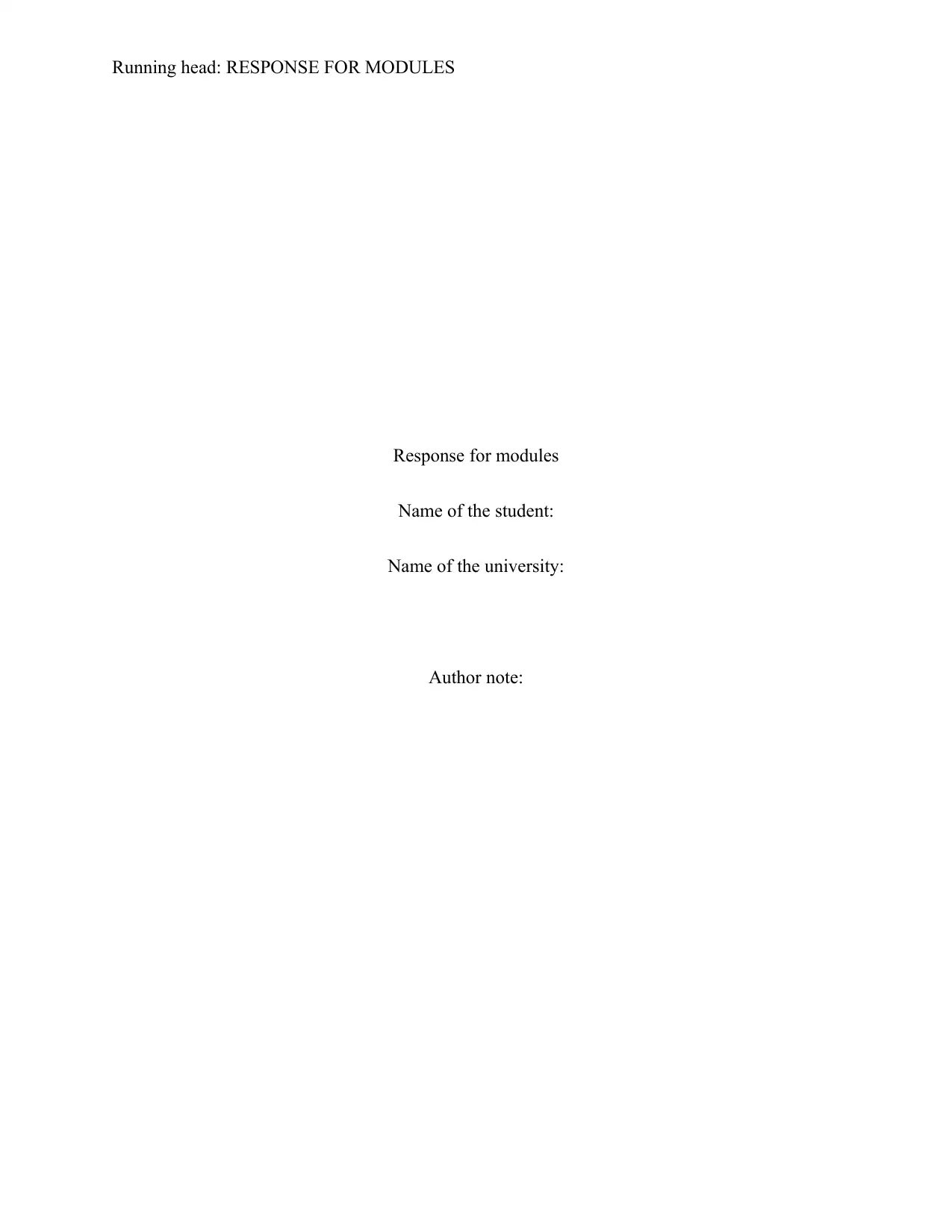
Running head: RESPONSE FOR MODULES
Response for modules
Name of the student:
Name of the university:
Author note:
Response for modules
Name of the student:
Name of the university:
Author note:
Secure Best Marks with AI Grader
Need help grading? Try our AI Grader for instant feedback on your assignments.
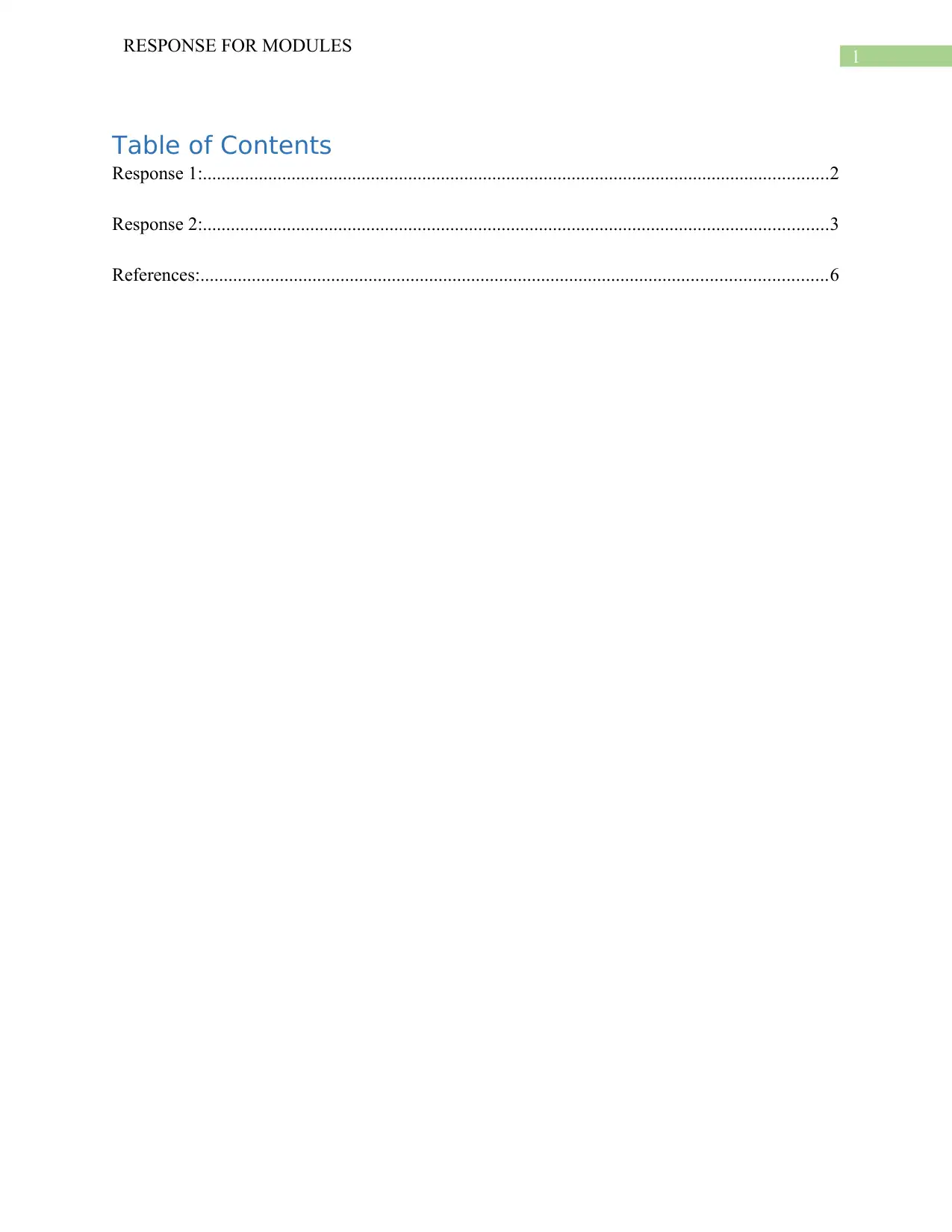
1
RESPONSE FOR MODULES
Table of Contents
Response 1:......................................................................................................................................2
Response 2:......................................................................................................................................3
References:......................................................................................................................................6
RESPONSE FOR MODULES
Table of Contents
Response 1:......................................................................................................................................2
Response 2:......................................................................................................................................3
References:......................................................................................................................................6
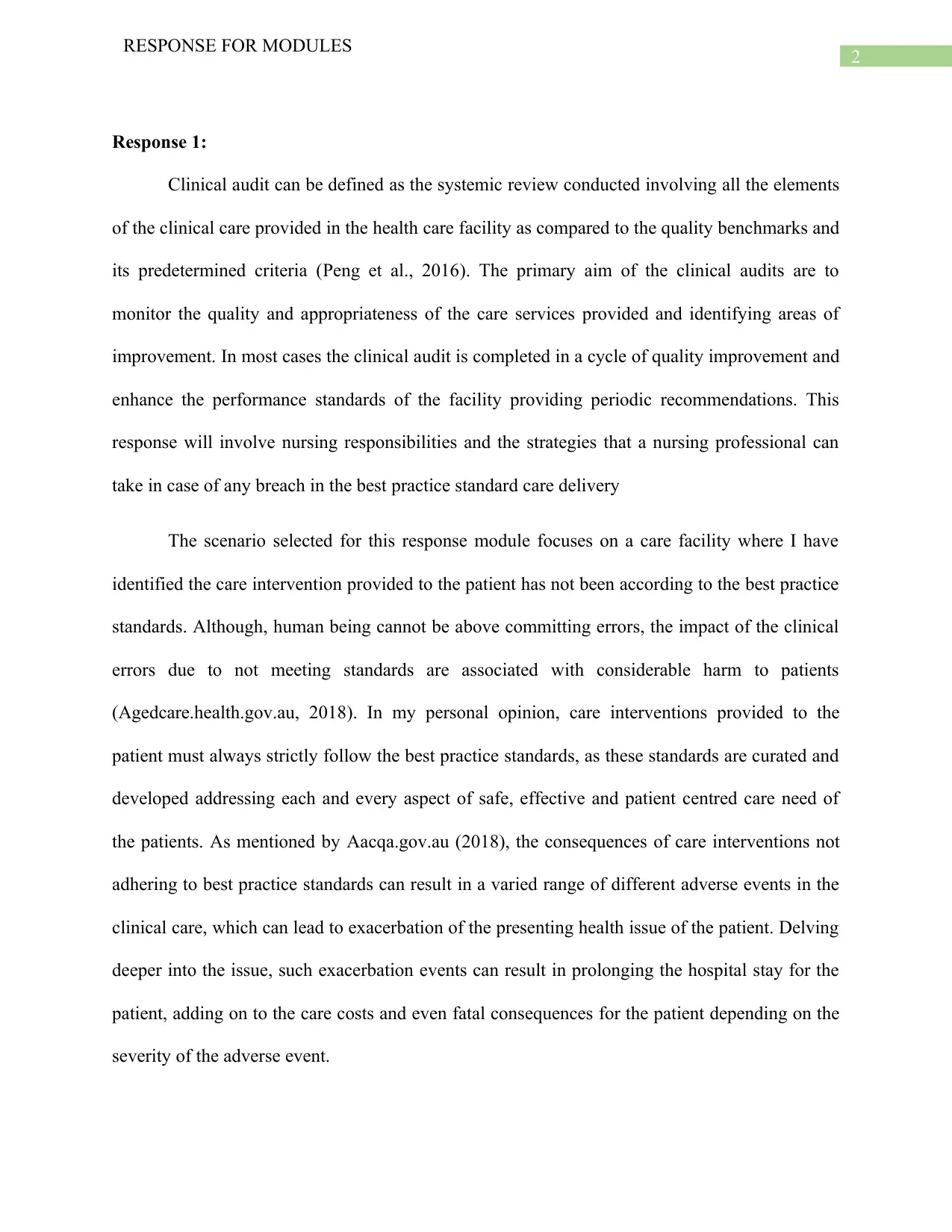
2
RESPONSE FOR MODULES
Response 1:
Clinical audit can be defined as the systemic review conducted involving all the elements
of the clinical care provided in the health care facility as compared to the quality benchmarks and
its predetermined criteria (Peng et al., 2016). The primary aim of the clinical audits are to
monitor the quality and appropriateness of the care services provided and identifying areas of
improvement. In most cases the clinical audit is completed in a cycle of quality improvement and
enhance the performance standards of the facility providing periodic recommendations. This
response will involve nursing responsibilities and the strategies that a nursing professional can
take in case of any breach in the best practice standard care delivery
The scenario selected for this response module focuses on a care facility where I have
identified the care intervention provided to the patient has not been according to the best practice
standards. Although, human being cannot be above committing errors, the impact of the clinical
errors due to not meeting standards are associated with considerable harm to patients
(Agedcare.health.gov.au, 2018). In my personal opinion, care interventions provided to the
patient must always strictly follow the best practice standards, as these standards are curated and
developed addressing each and every aspect of safe, effective and patient centred care need of
the patients. As mentioned by Aacqa.gov.au (2018), the consequences of care interventions not
adhering to best practice standards can result in a varied range of different adverse events in the
clinical care, which can lead to exacerbation of the presenting health issue of the patient. Delving
deeper into the issue, such exacerbation events can result in prolonging the hospital stay for the
patient, adding on to the care costs and even fatal consequences for the patient depending on the
severity of the adverse event.
RESPONSE FOR MODULES
Response 1:
Clinical audit can be defined as the systemic review conducted involving all the elements
of the clinical care provided in the health care facility as compared to the quality benchmarks and
its predetermined criteria (Peng et al., 2016). The primary aim of the clinical audits are to
monitor the quality and appropriateness of the care services provided and identifying areas of
improvement. In most cases the clinical audit is completed in a cycle of quality improvement and
enhance the performance standards of the facility providing periodic recommendations. This
response will involve nursing responsibilities and the strategies that a nursing professional can
take in case of any breach in the best practice standard care delivery
The scenario selected for this response module focuses on a care facility where I have
identified the care intervention provided to the patient has not been according to the best practice
standards. Although, human being cannot be above committing errors, the impact of the clinical
errors due to not meeting standards are associated with considerable harm to patients
(Agedcare.health.gov.au, 2018). In my personal opinion, care interventions provided to the
patient must always strictly follow the best practice standards, as these standards are curated and
developed addressing each and every aspect of safe, effective and patient centred care need of
the patients. As mentioned by Aacqa.gov.au (2018), the consequences of care interventions not
adhering to best practice standards can result in a varied range of different adverse events in the
clinical care, which can lead to exacerbation of the presenting health issue of the patient. Delving
deeper into the issue, such exacerbation events can result in prolonging the hospital stay for the
patient, adding on to the care costs and even fatal consequences for the patient depending on the
severity of the adverse event.
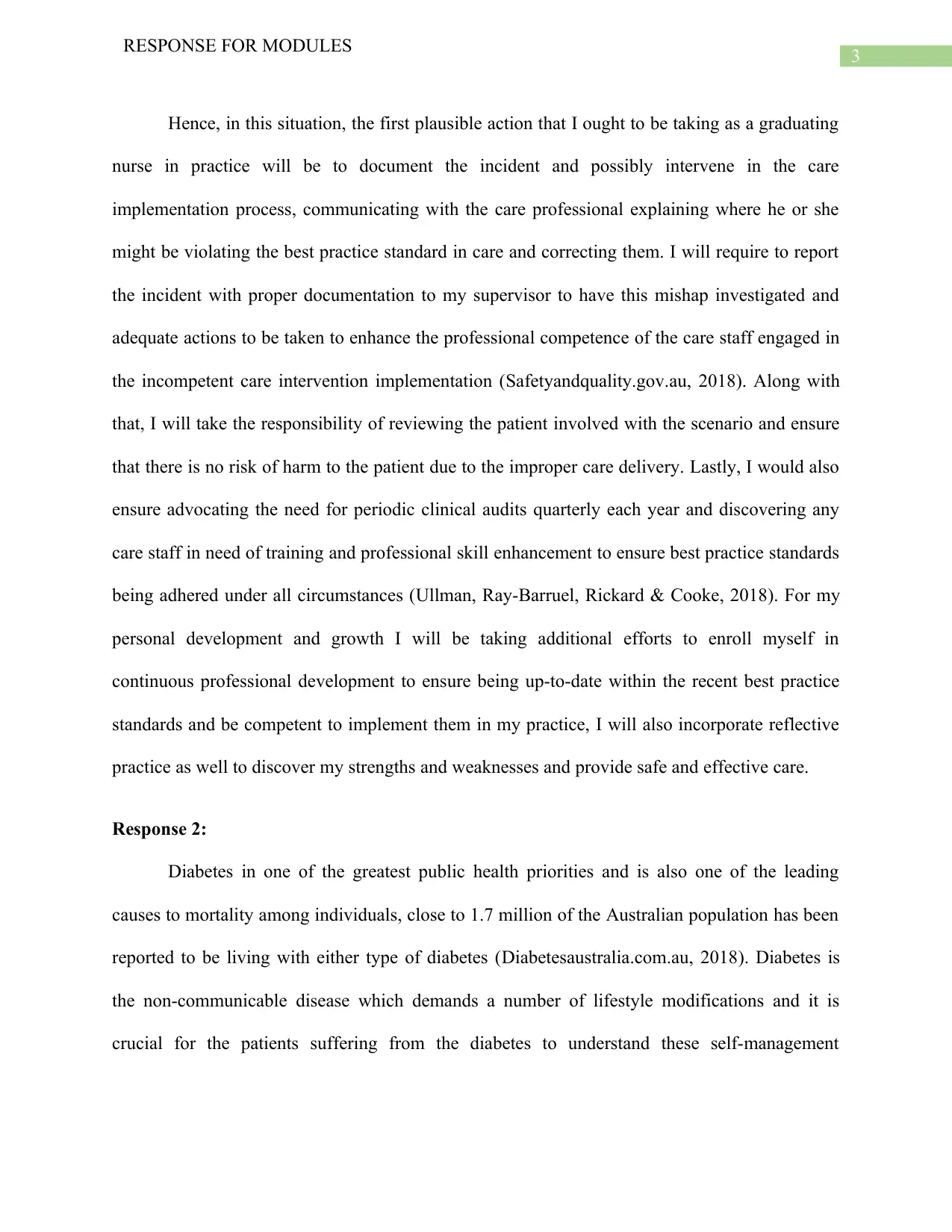
3
RESPONSE FOR MODULES
Hence, in this situation, the first plausible action that I ought to be taking as a graduating
nurse in practice will be to document the incident and possibly intervene in the care
implementation process, communicating with the care professional explaining where he or she
might be violating the best practice standard in care and correcting them. I will require to report
the incident with proper documentation to my supervisor to have this mishap investigated and
adequate actions to be taken to enhance the professional competence of the care staff engaged in
the incompetent care intervention implementation (Safetyandquality.gov.au, 2018). Along with
that, I will take the responsibility of reviewing the patient involved with the scenario and ensure
that there is no risk of harm to the patient due to the improper care delivery. Lastly, I would also
ensure advocating the need for periodic clinical audits quarterly each year and discovering any
care staff in need of training and professional skill enhancement to ensure best practice standards
being adhered under all circumstances (Ullman, Ray-Barruel, Rickard & Cooke, 2018). For my
personal development and growth I will be taking additional efforts to enroll myself in
continuous professional development to ensure being up-to-date within the recent best practice
standards and be competent to implement them in my practice, I will also incorporate reflective
practice as well to discover my strengths and weaknesses and provide safe and effective care.
Response 2:
Diabetes in one of the greatest public health priorities and is also one of the leading
causes to mortality among individuals, close to 1.7 million of the Australian population has been
reported to be living with either type of diabetes (Diabetesaustralia.com.au, 2018). Diabetes is
the non-communicable disease which demands a number of lifestyle modifications and it is
crucial for the patients suffering from the diabetes to understand these self-management
RESPONSE FOR MODULES
Hence, in this situation, the first plausible action that I ought to be taking as a graduating
nurse in practice will be to document the incident and possibly intervene in the care
implementation process, communicating with the care professional explaining where he or she
might be violating the best practice standard in care and correcting them. I will require to report
the incident with proper documentation to my supervisor to have this mishap investigated and
adequate actions to be taken to enhance the professional competence of the care staff engaged in
the incompetent care intervention implementation (Safetyandquality.gov.au, 2018). Along with
that, I will take the responsibility of reviewing the patient involved with the scenario and ensure
that there is no risk of harm to the patient due to the improper care delivery. Lastly, I would also
ensure advocating the need for periodic clinical audits quarterly each year and discovering any
care staff in need of training and professional skill enhancement to ensure best practice standards
being adhered under all circumstances (Ullman, Ray-Barruel, Rickard & Cooke, 2018). For my
personal development and growth I will be taking additional efforts to enroll myself in
continuous professional development to ensure being up-to-date within the recent best practice
standards and be competent to implement them in my practice, I will also incorporate reflective
practice as well to discover my strengths and weaknesses and provide safe and effective care.
Response 2:
Diabetes in one of the greatest public health priorities and is also one of the leading
causes to mortality among individuals, close to 1.7 million of the Australian population has been
reported to be living with either type of diabetes (Diabetesaustralia.com.au, 2018). Diabetes is
the non-communicable disease which demands a number of lifestyle modifications and it is
crucial for the patients suffering from the diabetes to understand these self-management
Secure Best Marks with AI Grader
Need help grading? Try our AI Grader for instant feedback on your assignments.
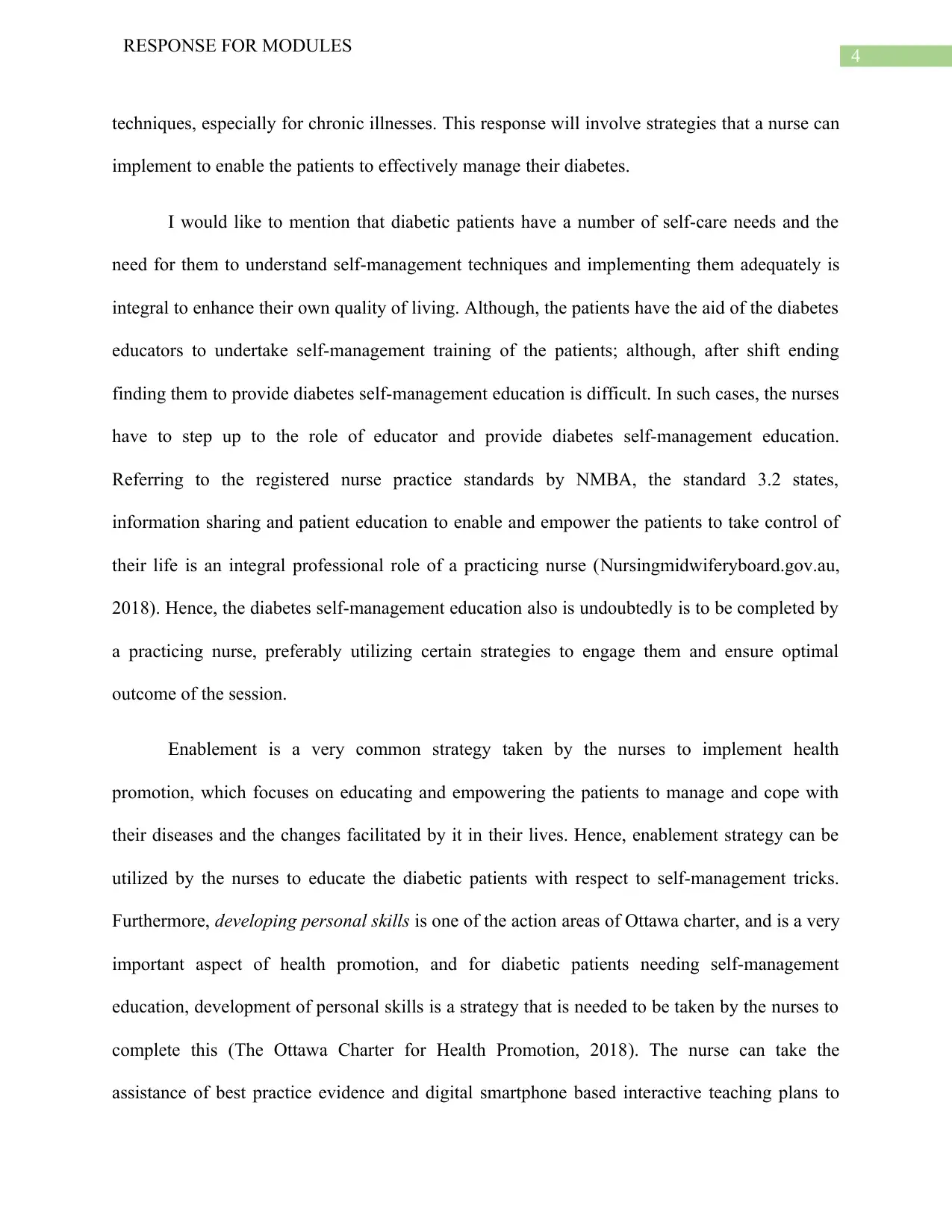
4
RESPONSE FOR MODULES
techniques, especially for chronic illnesses. This response will involve strategies that a nurse can
implement to enable the patients to effectively manage their diabetes.
I would like to mention that diabetic patients have a number of self-care needs and the
need for them to understand self-management techniques and implementing them adequately is
integral to enhance their own quality of living. Although, the patients have the aid of the diabetes
educators to undertake self-management training of the patients; although, after shift ending
finding them to provide diabetes self-management education is difficult. In such cases, the nurses
have to step up to the role of educator and provide diabetes self-management education.
Referring to the registered nurse practice standards by NMBA, the standard 3.2 states,
information sharing and patient education to enable and empower the patients to take control of
their life is an integral professional role of a practicing nurse (Nursingmidwiferyboard.gov.au,
2018). Hence, the diabetes self-management education also is undoubtedly is to be completed by
a practicing nurse, preferably utilizing certain strategies to engage them and ensure optimal
outcome of the session.
Enablement is a very common strategy taken by the nurses to implement health
promotion, which focuses on educating and empowering the patients to manage and cope with
their diseases and the changes facilitated by it in their lives. Hence, enablement strategy can be
utilized by the nurses to educate the diabetic patients with respect to self-management tricks.
Furthermore, developing personal skills is one of the action areas of Ottawa charter, and is a very
important aspect of health promotion, and for diabetic patients needing self-management
education, development of personal skills is a strategy that is needed to be taken by the nurses to
complete this (The Ottawa Charter for Health Promotion, 2018). The nurse can take the
assistance of best practice evidence and digital smartphone based interactive teaching plans to
RESPONSE FOR MODULES
techniques, especially for chronic illnesses. This response will involve strategies that a nurse can
implement to enable the patients to effectively manage their diabetes.
I would like to mention that diabetic patients have a number of self-care needs and the
need for them to understand self-management techniques and implementing them adequately is
integral to enhance their own quality of living. Although, the patients have the aid of the diabetes
educators to undertake self-management training of the patients; although, after shift ending
finding them to provide diabetes self-management education is difficult. In such cases, the nurses
have to step up to the role of educator and provide diabetes self-management education.
Referring to the registered nurse practice standards by NMBA, the standard 3.2 states,
information sharing and patient education to enable and empower the patients to take control of
their life is an integral professional role of a practicing nurse (Nursingmidwiferyboard.gov.au,
2018). Hence, the diabetes self-management education also is undoubtedly is to be completed by
a practicing nurse, preferably utilizing certain strategies to engage them and ensure optimal
outcome of the session.
Enablement is a very common strategy taken by the nurses to implement health
promotion, which focuses on educating and empowering the patients to manage and cope with
their diseases and the changes facilitated by it in their lives. Hence, enablement strategy can be
utilized by the nurses to educate the diabetic patients with respect to self-management tricks.
Furthermore, developing personal skills is one of the action areas of Ottawa charter, and is a very
important aspect of health promotion, and for diabetic patients needing self-management
education, development of personal skills is a strategy that is needed to be taken by the nurses to
complete this (The Ottawa Charter for Health Promotion, 2018). The nurse can take the
assistance of best practice evidence and digital smartphone based interactive teaching plans to
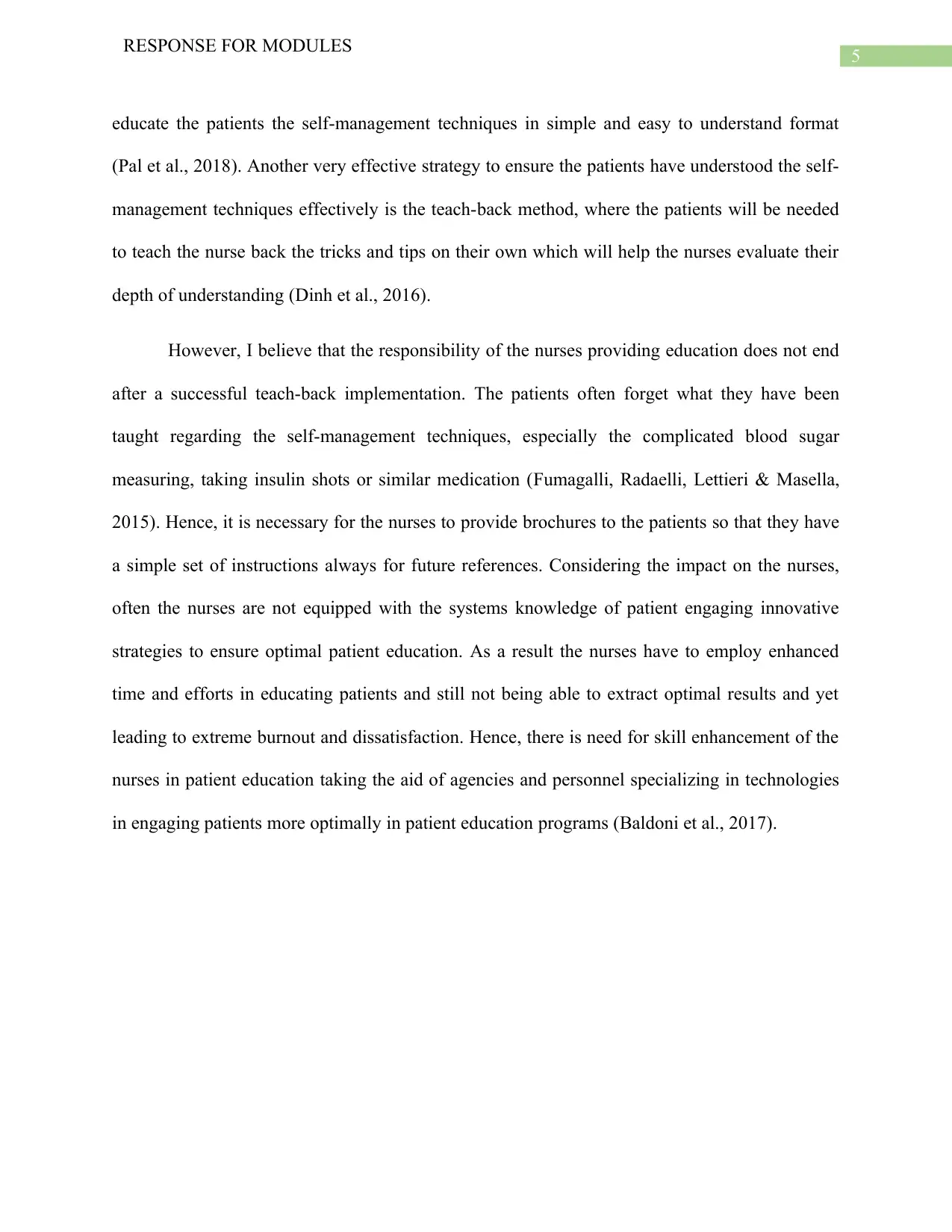
5
RESPONSE FOR MODULES
educate the patients the self-management techniques in simple and easy to understand format
(Pal et al., 2018). Another very effective strategy to ensure the patients have understood the self-
management techniques effectively is the teach-back method, where the patients will be needed
to teach the nurse back the tricks and tips on their own which will help the nurses evaluate their
depth of understanding (Dinh et al., 2016).
However, I believe that the responsibility of the nurses providing education does not end
after a successful teach-back implementation. The patients often forget what they have been
taught regarding the self-management techniques, especially the complicated blood sugar
measuring, taking insulin shots or similar medication (Fumagalli, Radaelli, Lettieri & Masella,
2015). Hence, it is necessary for the nurses to provide brochures to the patients so that they have
a simple set of instructions always for future references. Considering the impact on the nurses,
often the nurses are not equipped with the systems knowledge of patient engaging innovative
strategies to ensure optimal patient education. As a result the nurses have to employ enhanced
time and efforts in educating patients and still not being able to extract optimal results and yet
leading to extreme burnout and dissatisfaction. Hence, there is need for skill enhancement of the
nurses in patient education taking the aid of agencies and personnel specializing in technologies
in engaging patients more optimally in patient education programs (Baldoni et al., 2017).
RESPONSE FOR MODULES
educate the patients the self-management techniques in simple and easy to understand format
(Pal et al., 2018). Another very effective strategy to ensure the patients have understood the self-
management techniques effectively is the teach-back method, where the patients will be needed
to teach the nurse back the tricks and tips on their own which will help the nurses evaluate their
depth of understanding (Dinh et al., 2016).
However, I believe that the responsibility of the nurses providing education does not end
after a successful teach-back implementation. The patients often forget what they have been
taught regarding the self-management techniques, especially the complicated blood sugar
measuring, taking insulin shots or similar medication (Fumagalli, Radaelli, Lettieri & Masella,
2015). Hence, it is necessary for the nurses to provide brochures to the patients so that they have
a simple set of instructions always for future references. Considering the impact on the nurses,
often the nurses are not equipped with the systems knowledge of patient engaging innovative
strategies to ensure optimal patient education. As a result the nurses have to employ enhanced
time and efforts in educating patients and still not being able to extract optimal results and yet
leading to extreme burnout and dissatisfaction. Hence, there is need for skill enhancement of the
nurses in patient education taking the aid of agencies and personnel specializing in technologies
in engaging patients more optimally in patient education programs (Baldoni et al., 2017).
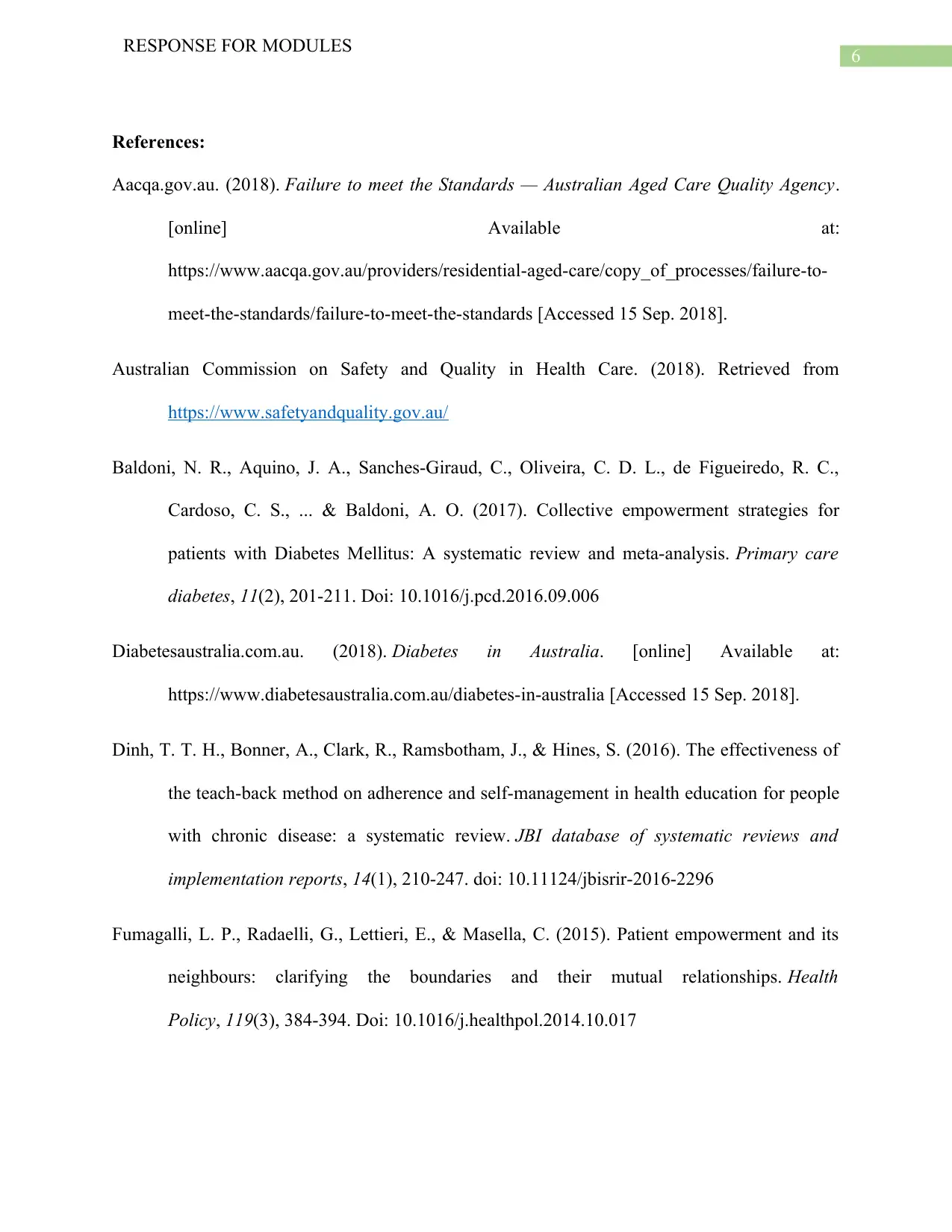
6
RESPONSE FOR MODULES
References:
Aacqa.gov.au. (2018). Failure to meet the Standards — Australian Aged Care Quality Agency.
[online] Available at:
https://www.aacqa.gov.au/providers/residential-aged-care/copy_of_processes/failure-to-
meet-the-standards/failure-to-meet-the-standards [Accessed 15 Sep. 2018].
Australian Commission on Safety and Quality in Health Care. (2018). Retrieved from
https://www.safetyandquality.gov.au/
Baldoni, N. R., Aquino, J. A., Sanches-Giraud, C., Oliveira, C. D. L., de Figueiredo, R. C.,
Cardoso, C. S., ... & Baldoni, A. O. (2017). Collective empowerment strategies for
patients with Diabetes Mellitus: A systematic review and meta-analysis. Primary care
diabetes, 11(2), 201-211. Doi: 10.1016/j.pcd.2016.09.006
Diabetesaustralia.com.au. (2018). Diabetes in Australia. [online] Available at:
https://www.diabetesaustralia.com.au/diabetes-in-australia [Accessed 15 Sep. 2018].
Dinh, T. T. H., Bonner, A., Clark, R., Ramsbotham, J., & Hines, S. (2016). The effectiveness of
the teach-back method on adherence and self-management in health education for people
with chronic disease: a systematic review. JBI database of systematic reviews and
implementation reports, 14(1), 210-247. doi: 10.11124/jbisrir-2016-2296
Fumagalli, L. P., Radaelli, G., Lettieri, E., & Masella, C. (2015). Patient empowerment and its
neighbours: clarifying the boundaries and their mutual relationships. Health
Policy, 119(3), 384-394. Doi: 10.1016/j.healthpol.2014.10.017
RESPONSE FOR MODULES
References:
Aacqa.gov.au. (2018). Failure to meet the Standards — Australian Aged Care Quality Agency.
[online] Available at:
https://www.aacqa.gov.au/providers/residential-aged-care/copy_of_processes/failure-to-
meet-the-standards/failure-to-meet-the-standards [Accessed 15 Sep. 2018].
Australian Commission on Safety and Quality in Health Care. (2018). Retrieved from
https://www.safetyandquality.gov.au/
Baldoni, N. R., Aquino, J. A., Sanches-Giraud, C., Oliveira, C. D. L., de Figueiredo, R. C.,
Cardoso, C. S., ... & Baldoni, A. O. (2017). Collective empowerment strategies for
patients with Diabetes Mellitus: A systematic review and meta-analysis. Primary care
diabetes, 11(2), 201-211. Doi: 10.1016/j.pcd.2016.09.006
Diabetesaustralia.com.au. (2018). Diabetes in Australia. [online] Available at:
https://www.diabetesaustralia.com.au/diabetes-in-australia [Accessed 15 Sep. 2018].
Dinh, T. T. H., Bonner, A., Clark, R., Ramsbotham, J., & Hines, S. (2016). The effectiveness of
the teach-back method on adherence and self-management in health education for people
with chronic disease: a systematic review. JBI database of systematic reviews and
implementation reports, 14(1), 210-247. doi: 10.11124/jbisrir-2016-2296
Fumagalli, L. P., Radaelli, G., Lettieri, E., & Masella, C. (2015). Patient empowerment and its
neighbours: clarifying the boundaries and their mutual relationships. Health
Policy, 119(3), 384-394. Doi: 10.1016/j.healthpol.2014.10.017
Paraphrase This Document
Need a fresh take? Get an instant paraphrase of this document with our AI Paraphraser
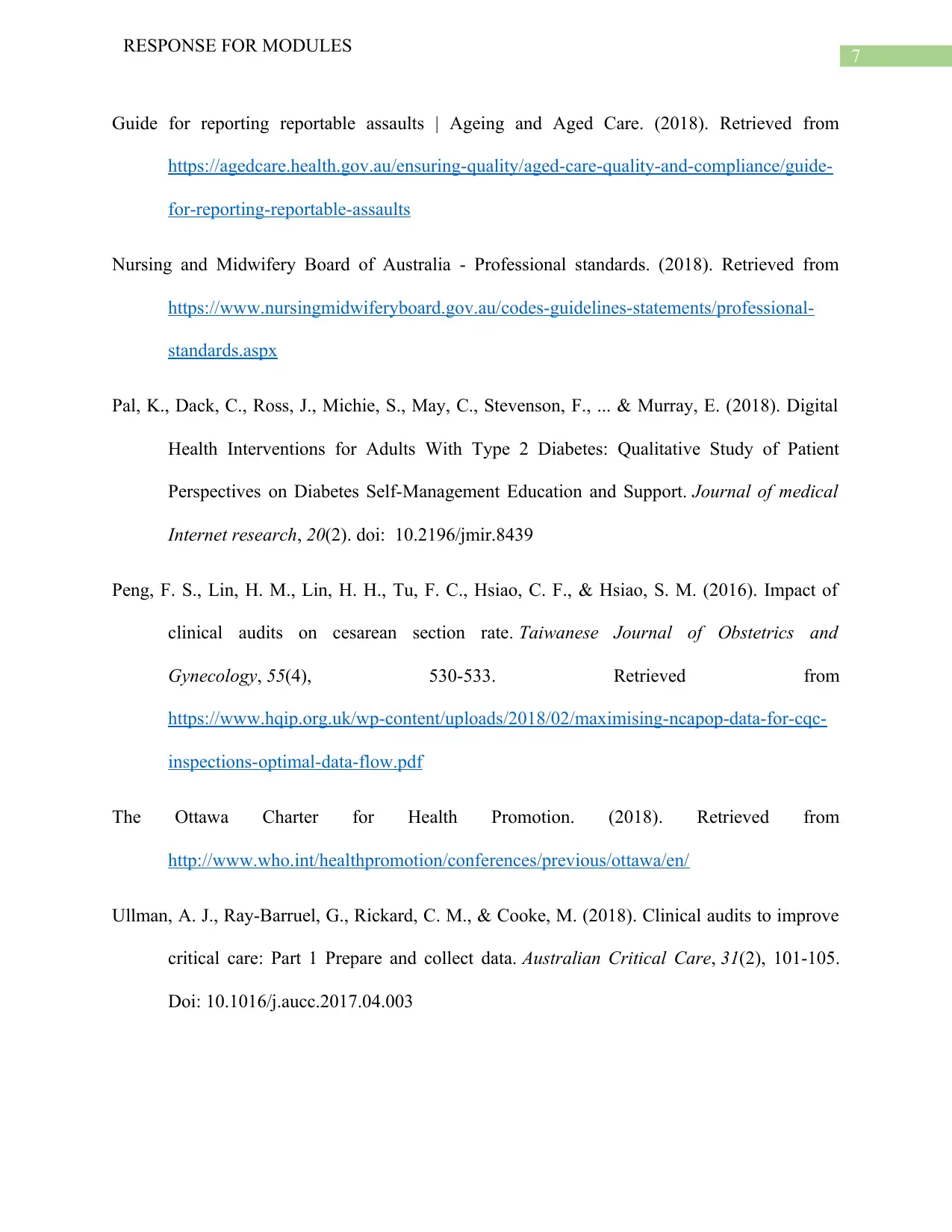
7
RESPONSE FOR MODULES
Guide for reporting reportable assaults | Ageing and Aged Care. (2018). Retrieved from
https://agedcare.health.gov.au/ensuring-quality/aged-care-quality-and-compliance/guide-
for-reporting-reportable-assaults
Nursing and Midwifery Board of Australia - Professional standards. (2018). Retrieved from
https://www.nursingmidwiferyboard.gov.au/codes-guidelines-statements/professional-
standards.aspx
Pal, K., Dack, C., Ross, J., Michie, S., May, C., Stevenson, F., ... & Murray, E. (2018). Digital
Health Interventions for Adults With Type 2 Diabetes: Qualitative Study of Patient
Perspectives on Diabetes Self-Management Education and Support. Journal of medical
Internet research, 20(2). doi: 10.2196/jmir.8439
Peng, F. S., Lin, H. M., Lin, H. H., Tu, F. C., Hsiao, C. F., & Hsiao, S. M. (2016). Impact of
clinical audits on cesarean section rate. Taiwanese Journal of Obstetrics and
Gynecology, 55(4), 530-533. Retrieved from
https://www.hqip.org.uk/wp-content/uploads/2018/02/maximising-ncapop-data-for-cqc-
inspections-optimal-data-flow.pdf
The Ottawa Charter for Health Promotion. (2018). Retrieved from
http://www.who.int/healthpromotion/conferences/previous/ottawa/en/
Ullman, A. J., Ray-Barruel, G., Rickard, C. M., & Cooke, M. (2018). Clinical audits to improve
critical care: Part 1 Prepare and collect data. Australian Critical Care, 31(2), 101-105.
Doi: 10.1016/j.aucc.2017.04.003
RESPONSE FOR MODULES
Guide for reporting reportable assaults | Ageing and Aged Care. (2018). Retrieved from
https://agedcare.health.gov.au/ensuring-quality/aged-care-quality-and-compliance/guide-
for-reporting-reportable-assaults
Nursing and Midwifery Board of Australia - Professional standards. (2018). Retrieved from
https://www.nursingmidwiferyboard.gov.au/codes-guidelines-statements/professional-
standards.aspx
Pal, K., Dack, C., Ross, J., Michie, S., May, C., Stevenson, F., ... & Murray, E. (2018). Digital
Health Interventions for Adults With Type 2 Diabetes: Qualitative Study of Patient
Perspectives on Diabetes Self-Management Education and Support. Journal of medical
Internet research, 20(2). doi: 10.2196/jmir.8439
Peng, F. S., Lin, H. M., Lin, H. H., Tu, F. C., Hsiao, C. F., & Hsiao, S. M. (2016). Impact of
clinical audits on cesarean section rate. Taiwanese Journal of Obstetrics and
Gynecology, 55(4), 530-533. Retrieved from
https://www.hqip.org.uk/wp-content/uploads/2018/02/maximising-ncapop-data-for-cqc-
inspections-optimal-data-flow.pdf
The Ottawa Charter for Health Promotion. (2018). Retrieved from
http://www.who.int/healthpromotion/conferences/previous/ottawa/en/
Ullman, A. J., Ray-Barruel, G., Rickard, C. M., & Cooke, M. (2018). Clinical audits to improve
critical care: Part 1 Prepare and collect data. Australian Critical Care, 31(2), 101-105.
Doi: 10.1016/j.aucc.2017.04.003
1 out of 8
Related Documents
Your All-in-One AI-Powered Toolkit for Academic Success.
+13062052269
info@desklib.com
Available 24*7 on WhatsApp / Email
![[object Object]](/_next/static/media/star-bottom.7253800d.svg)
Unlock your academic potential
© 2024 | Zucol Services PVT LTD | All rights reserved.





